DAY 1 (1/3): TSUKIJI OUTER MARKET (築地場外市場), Tokyo, Japan, 2018.05.25
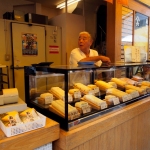
Walking out of Tsukiji Metro Station, our attention immediately fell to the monumental Tsukiji Honganji Temple (築地本願寺) across the street. Design in mixed styles including Indian Buddhist, Islamic and Hindu, as well as Western Neoclassical influences, architect and Tokyo University professor Chuta Ito intended to steer away from the traditional East Asian timber architectural traditions. Instead, he traveled to India numerous times to visit temples, and brought home design touches from the birthplace of Buddhism. The 1923 Great Kanto Earthquake destroyed the temple’s predecessor. The current Honganji Temple was built in the 1930s, and soon became a prominent Jodo Shinshu (浄土真宗) temple in Tokyo. We climbed the main stair and entered the main hall through an elegant doorway with beautiful stain-glass transom windows overhead. We were surprised to see a full house of audience in the cathedral-like main hall (even with an organ). Apparently there was a concert going on. A female vocalist was performing some kind of Western opera inside the temple.
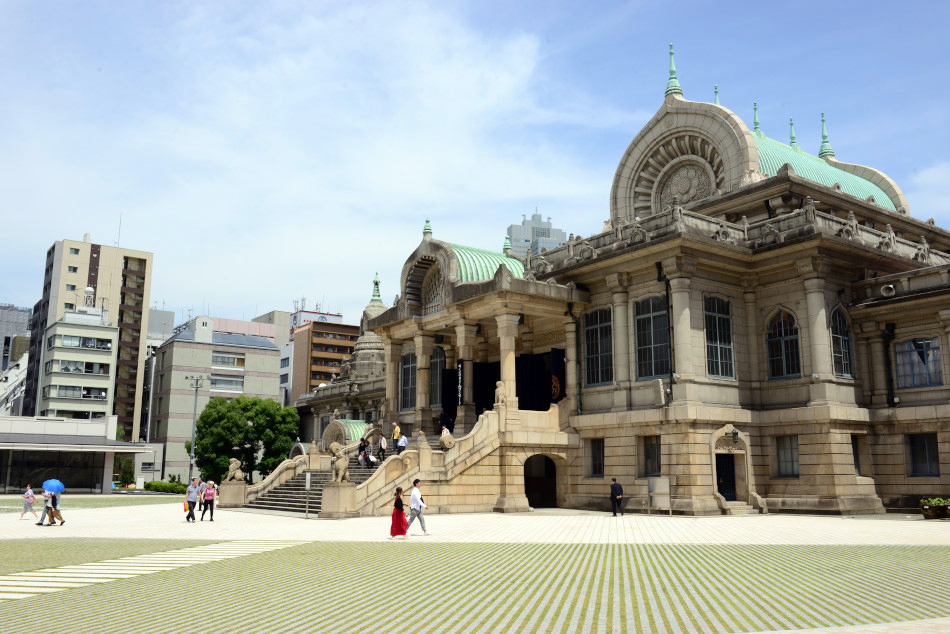 The unique facade of Tsukiji Honganji Temple hardly revealed its true identity of to us.
The unique facade of Tsukiji Honganji Temple hardly revealed its true identity of to us.
 The elegant stain glass transom over the doorway depict the Buddhist icon of lotus flowers.
The elegant stain glass transom over the doorway depict the Buddhist icon of lotus flowers.
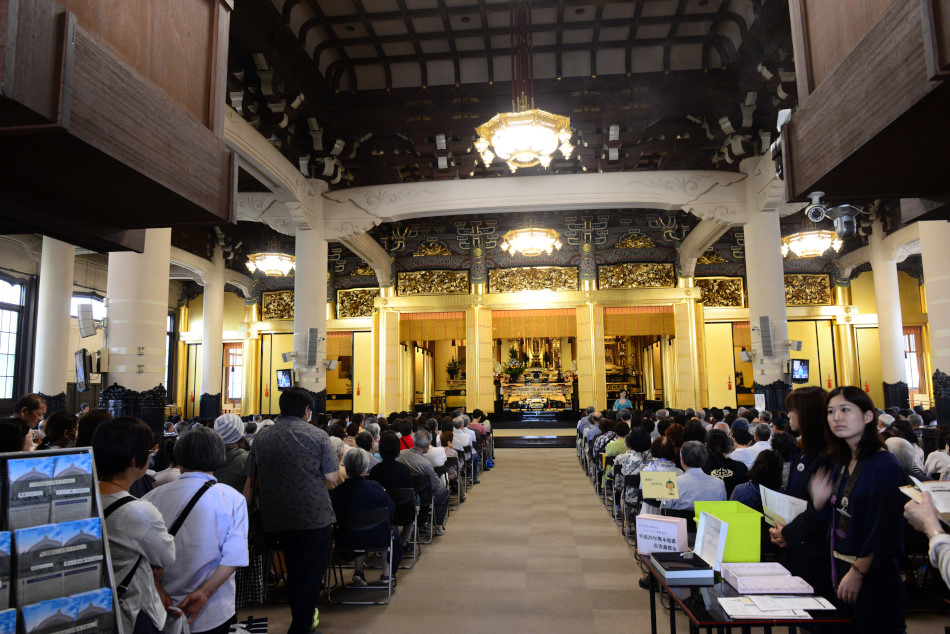 There was a concert inside the main hall of Tsukiji Honganji Temple.
There was a concert inside the main hall of Tsukiji Honganji Temple.
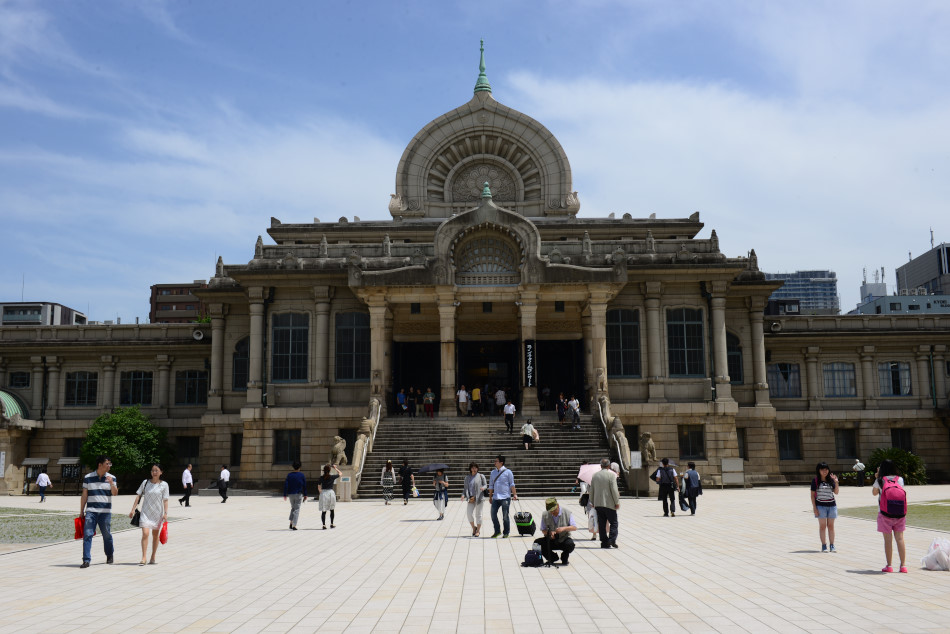 The architecture of Tsukiji Honganji Temple presents the trend of cultural fusion back in early 20th century.
The architecture of Tsukiji Honganji Temple presents the trend of cultural fusion back in early 20th century.
Across the street adjacent to the Tsukiji Honganji Temple, we picked a small lane leading into Tsukiji Jogai Shijo (築地場外市場) or the Outer Market. Encompassing a few blocks adjacent to the Tsukiji Jonai Shijo or the Inner Market, the Outer Market is a popular tourism attraction. Catered for the public, small shops selling all kinds of culinary-related goods from dried seafood to kitchen knives and food stalls offering a wide range of snacks such as sushi and grilled egg, the pedestrianized lanes of the Outer Market is truly a foodie’s paradise. On this piece of reclaimed land (Tsukiji literally means reclaimed land), the eateries and shops of the Outer Market had long been providing a diverse range of food to the people of Tokyo since the Showa Era (1926-1989). The entire Tsukiji Market was in fact a consequence of the Great Kanto Earthquake, which devastated Central Tokyo in 1923 including the Nihonbashi Fish Market. The fish market was relocated to Tsukiji and began to operate in 1935 as one of the three major markets in the city. Already the largest wholesale seafood market in the world, the Tsukiji Market is running out of space for further development. Work of relocating the market has been undergoing for sometime. After several delays, it seems that the market is really moving to its new home in Toyosu (豊洲) this October. But that didn’t affect the bustling Outer Market as these few blocks of shops and eateries (and the loads of tourists) would likely to stay even after the move.
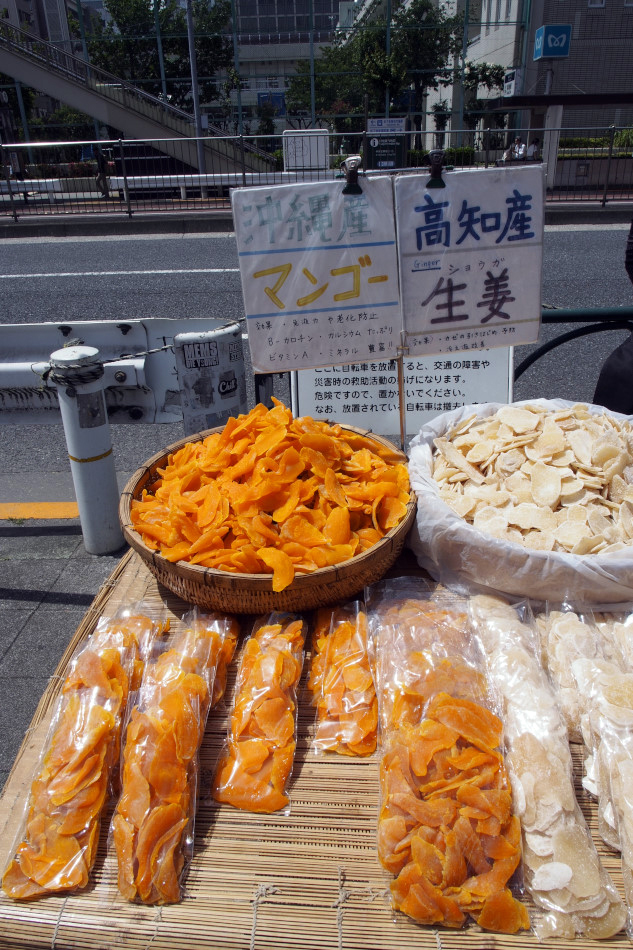 Street vendors appeared blocks away from the Tsukiji Market just outside the Metro Station.
Street vendors appeared blocks away from the Tsukiji Market just outside the Metro Station.
 A large fish painted on the building facade probably reminds tourists the direction of the market.
A large fish painted on the building facade probably reminds tourists the direction of the market.
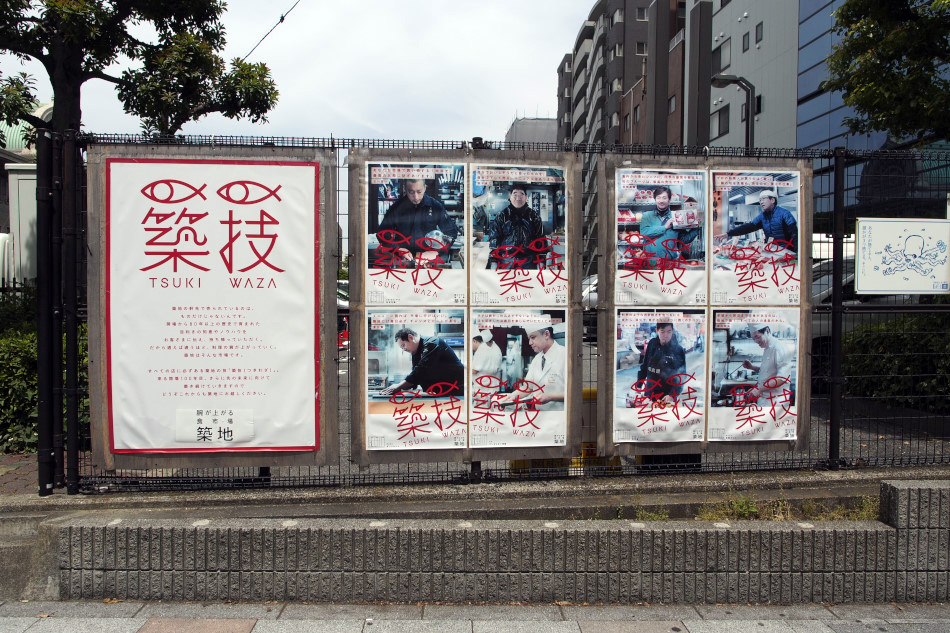 A relatively new market called “Tsuki Waza” will remain at Tsukiji even after the relocation of Tsukiji Inner Market.
A relatively new market called “Tsuki Waza” will remain at Tsukiji even after the relocation of Tsukiji Inner Market.
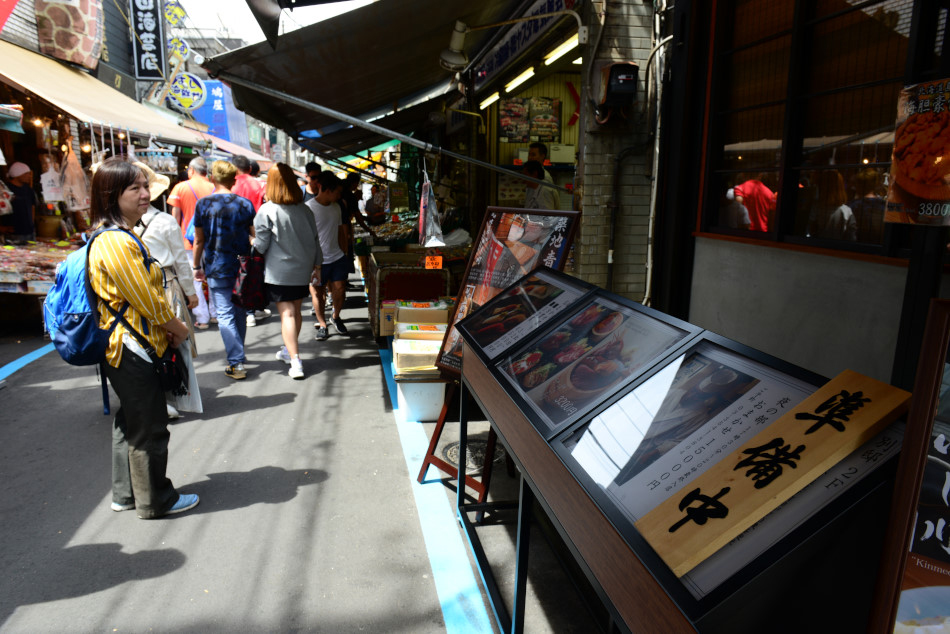 The Tsukiji Outer Market is consisted of a few pedestrianized streets of shops and restaurants.
The Tsukiji Outer Market is consisted of a few pedestrianized streets of shops and restaurants.
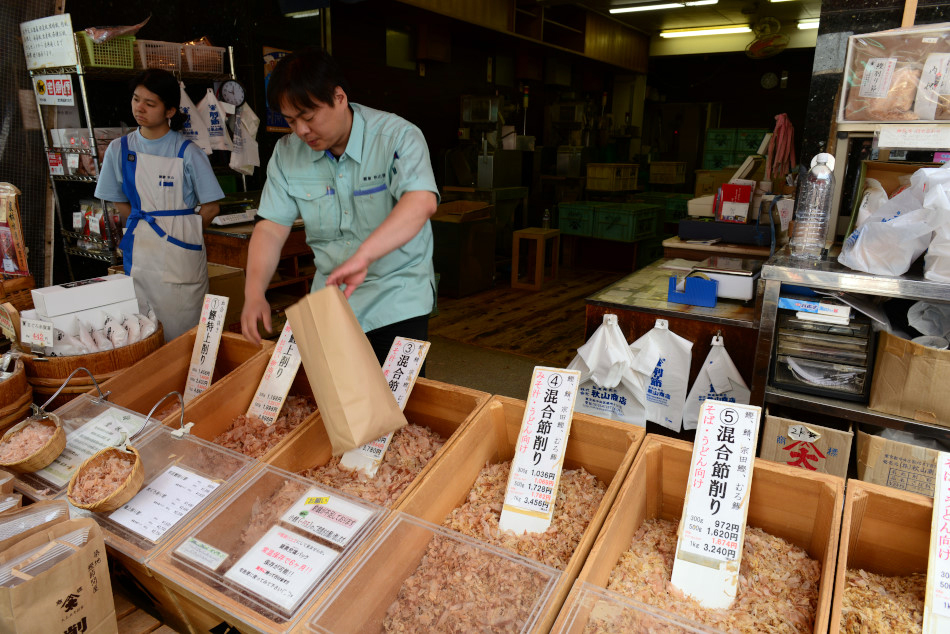 Katsuobushi (鰹節) is the dried, fermented and smoked skipjack tuna or bonito flakes commonly seen in Japanese cuisine.
Katsuobushi (鰹節) is the dried, fermented and smoked skipjack tuna or bonito flakes commonly seen in Japanese cuisine.
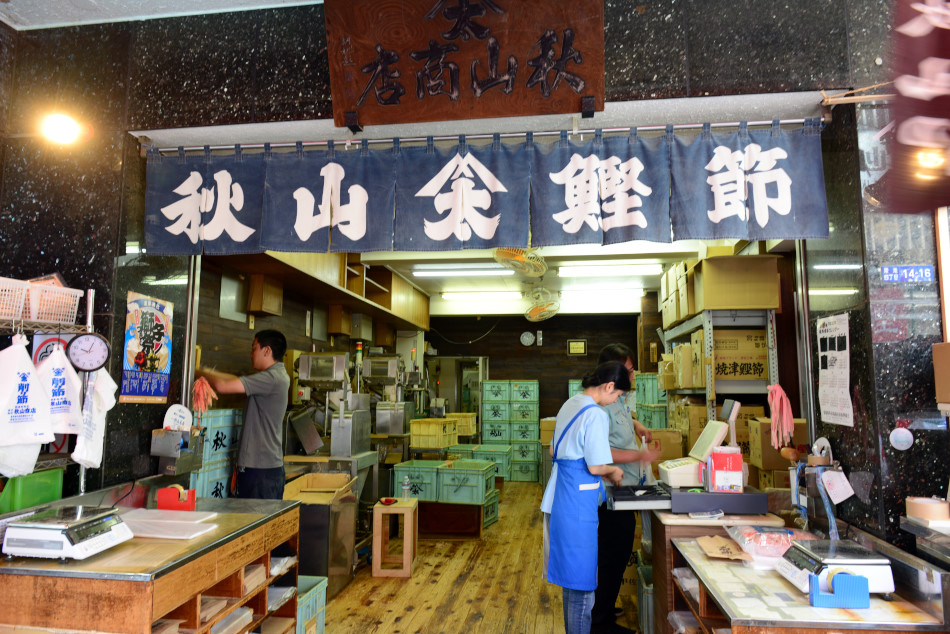 Akiyama Shouten (秋山商店) specializes in katsuobushi. We couldn’t resist but got ourselves 500g of the flakes.
Akiyama Shouten (秋山商店) specializes in katsuobushi. We couldn’t resist but got ourselves 500g of the flakes.
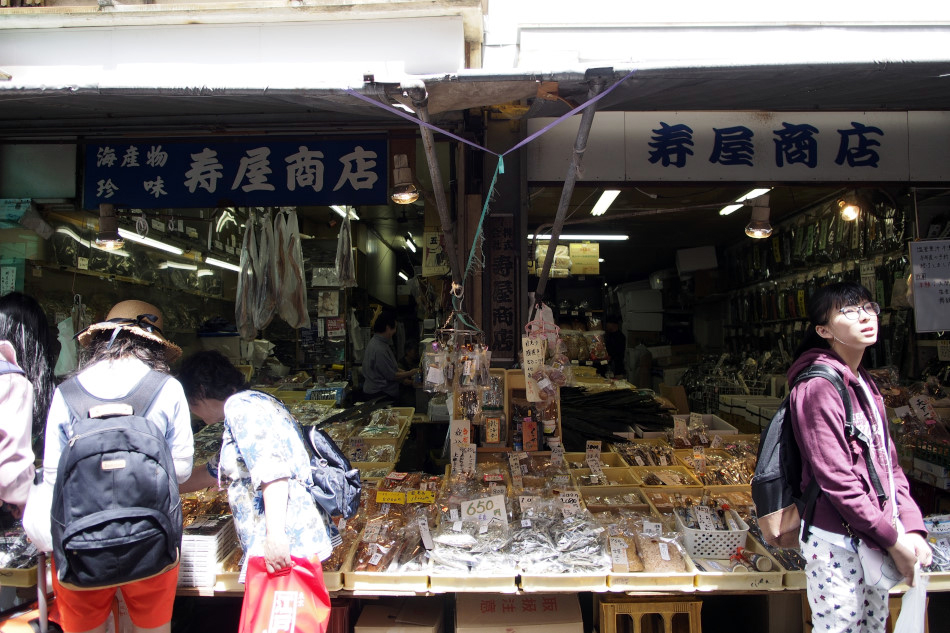 There are many small shops with all kinds of dried seafood and seaweed.
There are many small shops with all kinds of dried seafood and seaweed.
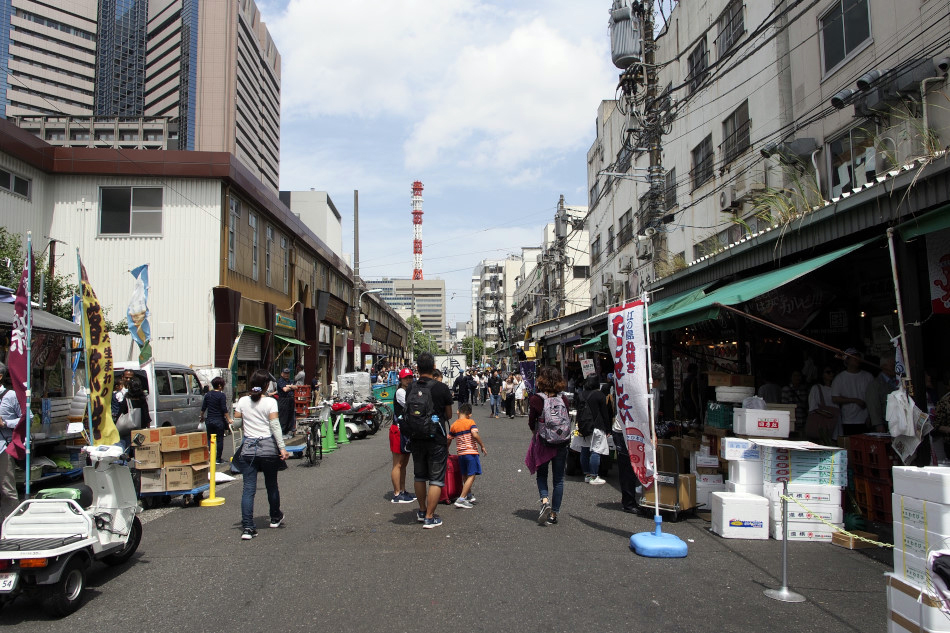 While it only occupies a few blocks, one can easily get disoriented in Tsukiji Outer Market.
While it only occupies a few blocks, one can easily get disoriented in Tsukiji Outer Market.
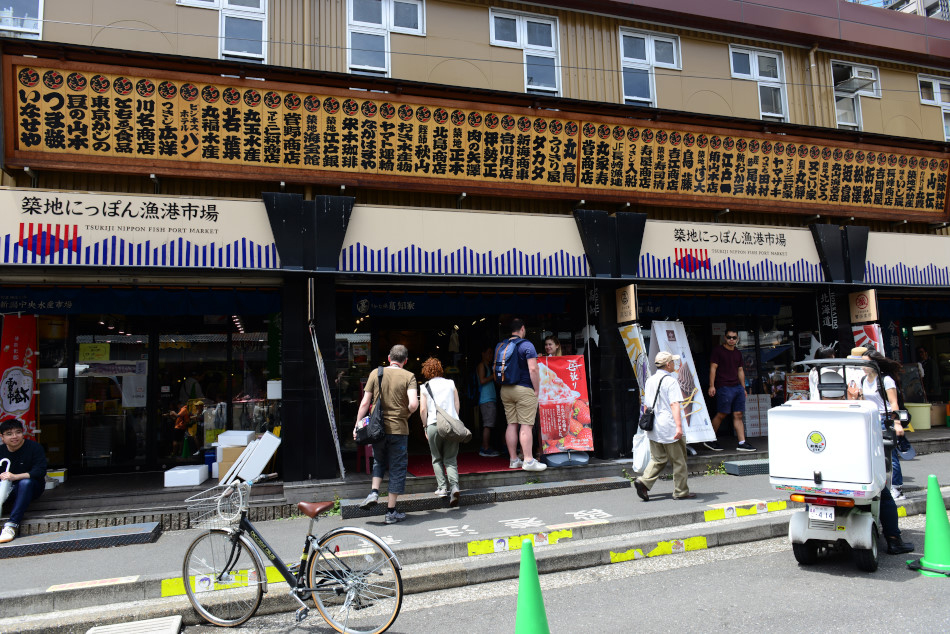 Apart from the small shops, there are also indoor shopping arcades of food stalls.
Apart from the small shops, there are also indoor shopping arcades of food stalls.
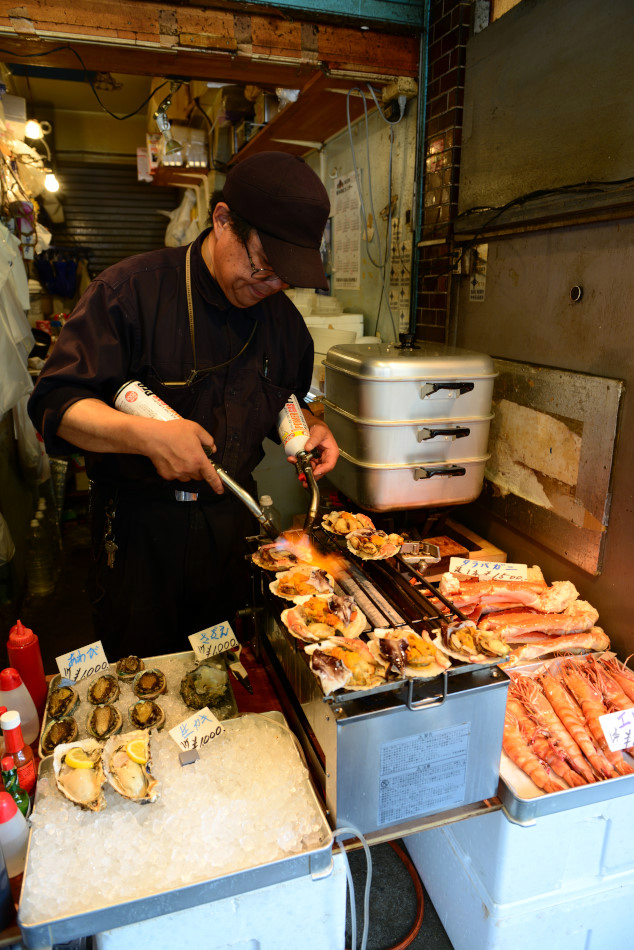 We ended up get our first snacks from a street BBQ vendor.
We ended up get our first snacks from a street BBQ vendor.
 Apart from seafood, spices can also be found in the Outer Market.
Apart from seafood, spices can also be found in the Outer Market.
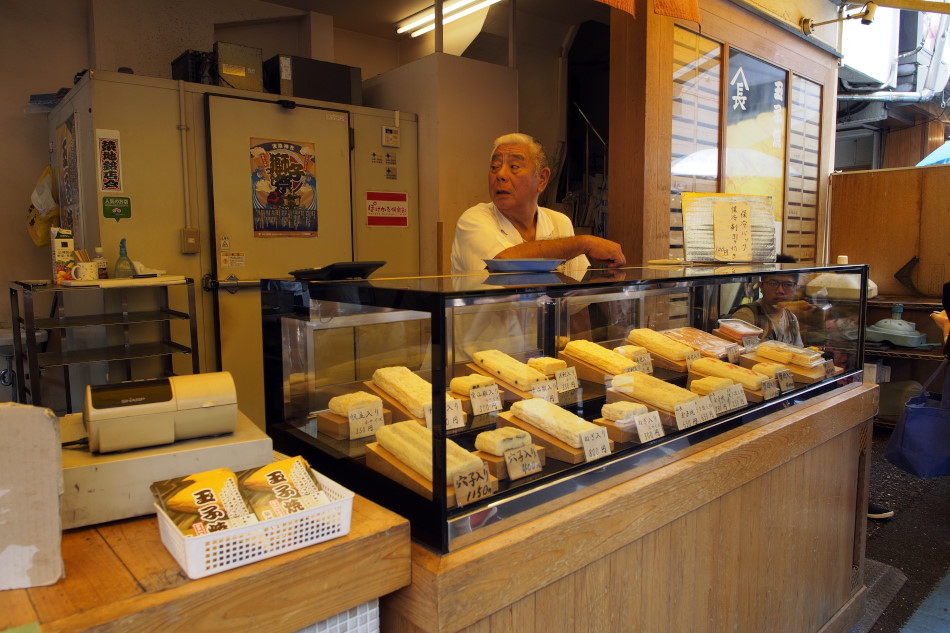 Tamagoyaki (玉子焼き) or grilled omelette is another popular snacks available at Tsukiji.
Tamagoyaki (玉子焼き) or grilled omelette is another popular snacks available at Tsukiji.
 We saw about four to five stalls specialized in tamagoyaki. We tried two of them and they both tasted good.
We saw about four to five stalls specialized in tamagoyaki. We tried two of them and they both tasted good.
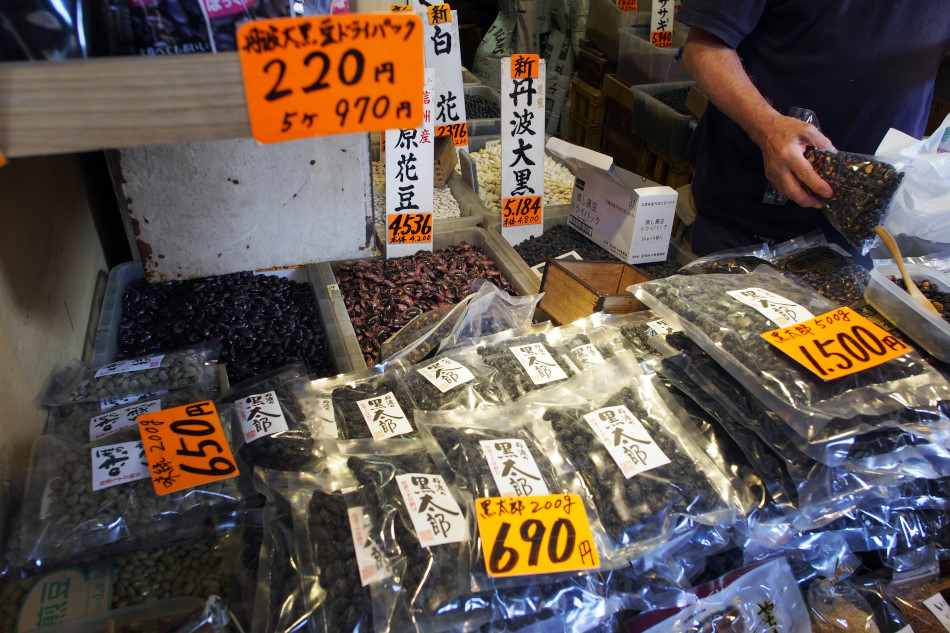 After free tasting of black beans from Kyoto region we ended up get a pack home.
After free tasting of black beans from Kyoto region we ended up get a pack home.
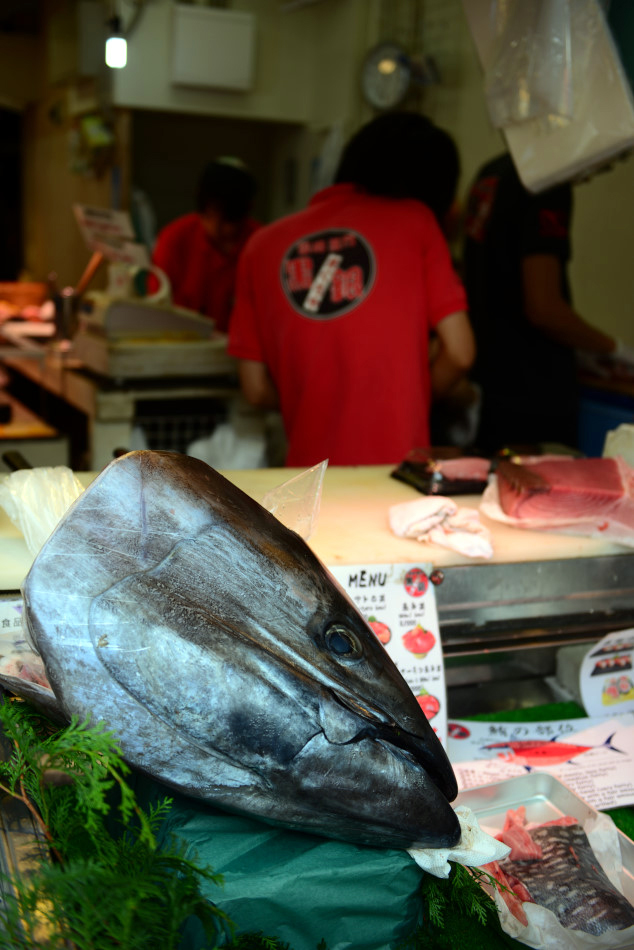 After all, tuna is still the king in Tsukiji. Quite a long queue of people were waiting for fresh tuna sashimi in front of this shop.
After all, tuna is still the king in Tsukiji. Quite a long queue of people were waiting for fresh tuna sashimi in front of this shop.
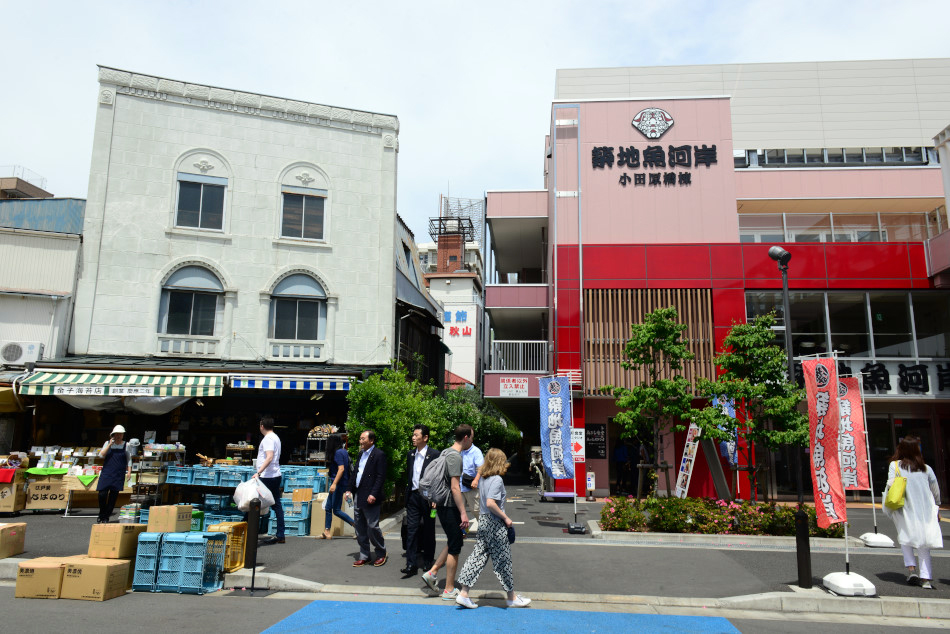 New indoor shopping arcades have been established in recent years at the Outer Market, perhaps as a gesture of confidence for the future of Tsukiji after the relocation of the wholesale Inner Market later this year.
New indoor shopping arcades have been established in recent years at the Outer Market, perhaps as a gesture of confidence for the future of Tsukiji after the relocation of the wholesale Inner Market later this year.
* * *
CHUBU (中部地方) 2018, Japan, 2018.05.25 – 06.03
Introduction
Day 1: Tokyo (東京)
1.1 TSUKIJI OUTER MARKET (築地場外市場)
1.2 TSUKIJI INNER MARKET (築地中央卸売市場)
1.3 MORI ART MUSEUM (森美術館), 21_21 DESIGN SIGHT & CAFE KITSUNE
Day 2: Matsumoto (松本)& Kamikochi (上高地)
2.1 MATSUMOTO CASTLE (松本城), Matsumoto (松本)
2.2 “ALL ABOUT MY LOVE”, Yayoi Kusama’s Exhibition at Matsumoto City Museum of Art (松本市美術館), Matsumoto (松本)
2.3 MATSUMOTO PERFORMING ARTS CENTER (まつもと市民芸術館), Matsumoto (松本)
2.4 FROM MATSUMOTO (松本) TO KAMIKOCHI (上高地)
2.5 ARRIVAL IN KAMIKOCHI (上高地), Chūbu-Sangaku National Park (中部山岳国立公園)
Day 3: Kamikochi (上高地)
3.1 MORNING WALK IN KAMIKOCHI (上高地), Nagano Prefecture (長野県)
3.2 DAKESAWA HIKE (岳沢), Kamikochi (上高地)
Day 4: Kamikochi (上高地) & Shirahone Onsen (白骨温泉)
4.1 TAISHO POND (大正池), Kamikochi (上高地)
4.2 RETREAT IN THE JAPANESE ALPS, Shirahone Onsen (白骨温泉)
4.3 MOMENTS OF ESCAPE, Tsuruya Ryokan (つるや旅館), Shirahone Onsen (白骨温泉)
Day 5: Hida-Takayama (飛騨高山)
5.1 CITY IN THE MOUNTAINS, Hida-Takayama (飛騨高山)
5.2 HIDA BEEF (飛騨牛), Hida-Takayama (飛騨高山)
5.3 SAKE (日本酒) BREWERIES, Hida-Takayama (飛騨高山)
5.4 YOSHIJIMA HOUSE (吉島家住宅), Hida-Takayama (飛騨高山)
5.5 HIGASHIYAMA WALKING COURSE (東山遊歩道), Hida-Takayama (飛騨高山)
Day 6: Hida-Takayama (飛騨高山), Shirakawa-go (白川郷) & Ainokura (相倉)
6.1 MIYAGAWA MORNING MARKET (宮川朝市), Hida-Takayama (飛騨高山), Gifu Prefecture (岐阜県)
6.2 OGIMACHI IN THE RAIN, Shirakawa-go (白川郷), Gifu Prefecture (岐阜県)
6.3 SOBA, TEMPLE & LOOKOUT, Shirakawa-go (白川郷)
6.4 RAINY AFTERNOON IN AINOKURA (相倉), Gokayama (五箇山)
6.5 GASSHO MINSHUKU, FLOWER BEDS & RICE PADDY FIELDS, Ainokura (相倉), Gokayama (五箇山)
6.6 CROAKING FROGS AND MOONLIGHT REFLECTIONS, Gokayama (五箇山)
Day 7: Kanazawa (金沢)
7.1 DEPARTURE IN THE RAIN, Ainokura (相倉) to Kanazawa (金沢)
7.2 A SEAFOOD PARADISE – OMICHO MARKET (近江町市場)
7.3 D T Suzuki Museum (鈴木大拙館)
7.4 Kenroku-en Garden (兼六園)
7.5 Oyama Shrine (尾山神社) and Nagamachi Samurai District (長町)
7.6 Nomura Samurai House (武家屋敷跡 野村家), Nagamachi Samurai District (長町)
7.7 Sushi Ippei (一平鮨), Katamachi (片町)
Day 8: Kanazawa, Ishikawa Prefecture (金沢, 石川県)
8.1 Iki Iki Tei (いきいき亭) and Higashide Coffee (東出珈琲店), Omicho Market (近江町市場)
8.2 21st Century Museum of Contemporary Art (21世紀美術館)
8.3 Kazuemachi District (主計町茶屋街)
8.4 Higashi Chaya District (東山ひがし茶屋街)
8.5 Kaga Yuzen Toro Nagashi (加賀友禅燈ろう流し), Asano River (浅野川)
8.6 AFTERMATH OF KAGA YUZEN TORO NAGASHI (加賀友禅燈ろう流し)
Day 9 & 10: Tokyo (東京)
9.1 Marunouchi (丸の内) & Nihonbashi (日本橋)
10.1 OEDO ANTIQUE MARKET (大江戸骨董市), Tokyo Forum (東京国際フォーラム)
10.2 FARMER’S MARKET, United Nations University (東京国連大学), Aoyama (青山)
